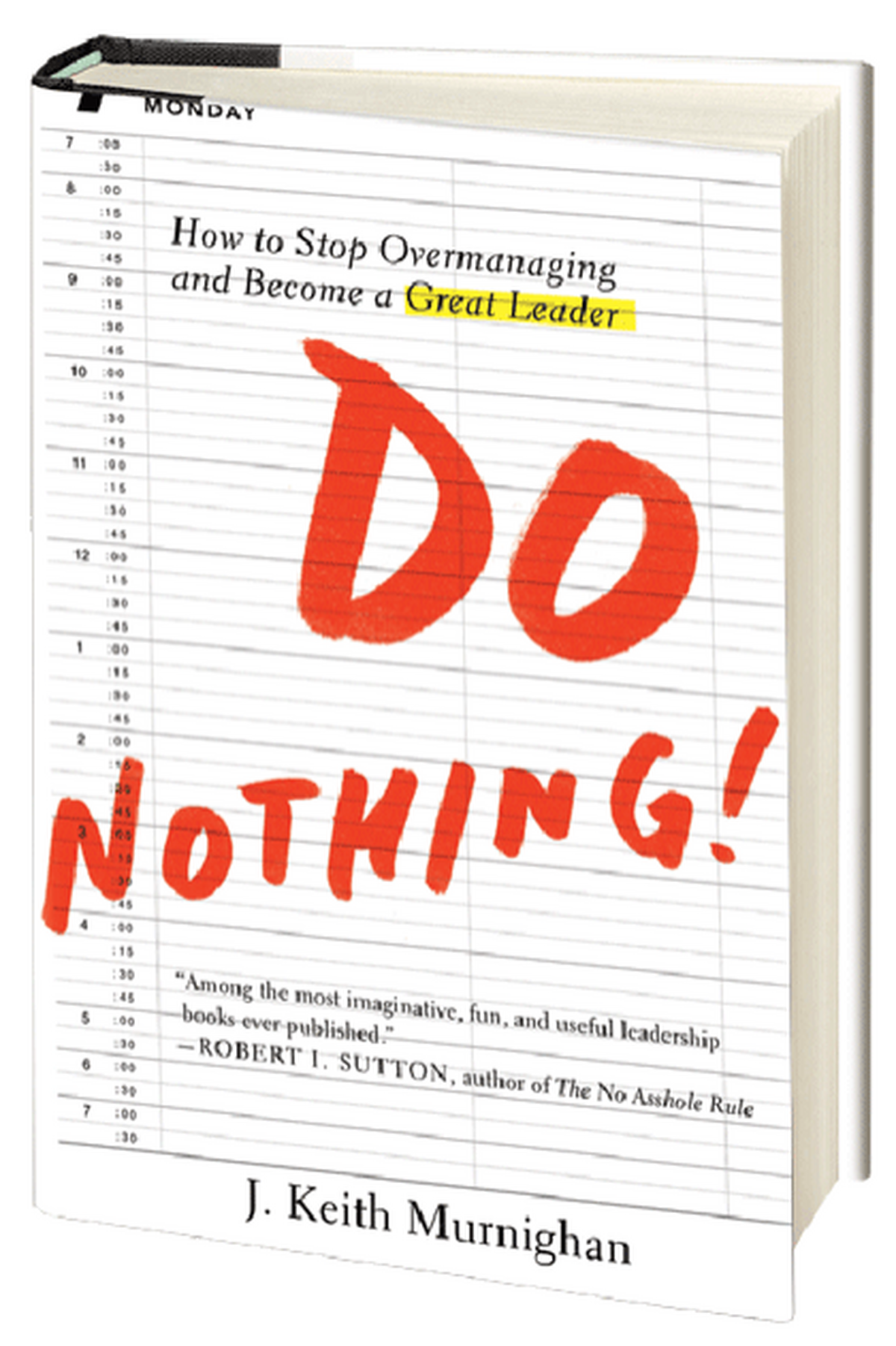
In looking at the great leaders of history—whether they are political leaders like Julius Caesar or business leaders like Steven P. Jobs—many people probably assume that they must have taken a particularly active role in running their organizations. Caesar, after all, personally led his troops into Gaul, and Jobs was famous for checking the design of even the smallest inner workings of every product at Apple.
But J. Keith Murnighan, a professor of management and organizations at the Kellogg School of Management, says that is not the best way to manage an organization. In his new book Do Nothing!: How to Stop Overmanaging and Become a Great Leader, Murnighan contends that the most successful leaders delegate virtually all the regular work to their staff, freeing their own time so that they can facilitate and orchestrate everyone else’s performance. Not only will that improve morale, he says, but it will also result in a better product and a less stressful life for the leader.
“Most leaders do too much,” Murnighan says. “And when they do, they’re seen as micromanagers.”
Stop Doing What You Do Well
The idea for the book grew out of Murnighan’s nearly four decades of teaching. He also utilized research by three fellow faculty members at the Kellogg School: Adam Galinsky, Victoria Medvec, and Loren Nordgren. Over the years, a key lesson Murnighan has taught students has been that “decision-making, negotiations, and team-building skills really are the essence of leadership.” He thought about turning that particular concept into a book, but then took it a step further. “As you realize the implications of what you’re teaching,” he says, “you want to take things to their logical extremes.” And the logical extreme of building a team of trusted employees and focusing on the big picture is that leaders should “do nothing” when it comes to everyday functioning.
In his classes, Murnighan says, he often asks his students—most of whom are executives or people who hope to become executives—“What would it be like if all of your team members were living up to their potential? That gets big smiles from everyone. Then I say, ‘Why don’t you just help them do that? All you have to do is orchestrate a bit and facilitate.’ ”
“Most leaders do too much,” Murnighan says. “And when they do, they’re seen as micromanagers.”
Unfortunately, that is easier said than done. “Doing nothing is not easy for people who like their work and are driven to succeed,” Murnighan concedes. A common problem is that people often get promoted to leadership positions because they have been very capable technicians. When they are promoted, it is critical that they stop doing the technical work and delegate. “Successful leaders must shift gears and, literally, do less of what they used to do, even though they were good at it,” Murnighan writes in the first chapter. Yet, “they feel so comfortable using their old, established skills that they often have a hard time changing.”
That refusal to let go creates a host of problems. Many leaders oversee teams whose members are “under-utilized and under-challenged.” These employees will not perform effectively, and ultimately the best workers may leave in frustration. Meanwhile, the leaders themselves are overstressed.
Start with Big Tests
Murnighan offers several strategies for learning to do nothing. For starters, leaders must seek out the most qualified employees and match them to assignments that utilize their skills.
Murnighan suggests that a leader’s initial impulse, upon taking over a new group, is to give people a small task, “to test them and to avoid risking much.” But that is the wrong approach, he warns. Instead, “do your homework by consulting your team members’ personnel files, with the express intention of finding out exactly how competent they are and what they have been currently working on.” Next, new leaders should go beyond their own comfort zones by trusting employees more than they have been trusted and assigning them jobs that reflect that. Essentially, they should ask their employees to do more. “Not a lot more, but a bit more,” he writes.
Of course, Murnighan is not really advising managers to literally do nothing and go play golf. Even after all this delegating, effective “do-nothing” leaders remain engaged. One key function, Murnighan says, is to walk the floor, “asking people two basic questions: ‘How are you?’ and ‘Is there anything I can do to make your job easier?’ ” As Murnighan sees it, these questions signal that a leader cares both about the employee and whether he or she is performing well. “If you feel that the CEO cares about you, you’re going to be more motivated to perform,” he adds.
To a good manager, the words like “facilitate” or “orchestrate” are not just empty jargon, Murnighan says. A leader can “help people succeed in what they are doing,” he writes. “[G]ive your best salesperson as many insights about your potential new customers as you and your team can provide…make sure that Annie finishes her work before William does his so that everything will be ready at the right time.”
“By doing less and less,” he adds, “you will have time to plan for the future.” Murnighan sums up his advice in what he calls his leadership law. “Think of the reactions you want first, then determine the actions that you should take to achieve them.”
Murnighan’s book cites two exceptions to “Do Nothing” leadership: “When you are the only one with the skills needed for an urgent task” and “When dirty work needs to be done.” The former case, Murnighan adds, should only happen once. After that, a company should train an existing employee in the missing skills or hire someone who can handle them.
The Boss Always Gets the Credit
Doing nothing creates all sorts of benefits: a more satisfied work force, a better end-product, lower turnover, more time for planning, and more relaxed managers. “People on your team will reveal skills that you never knew they had, and they will accomplish things that go far beyond your estimate of their capabilities,” Murnighan writes.
In addition, he predicts, “leaders can cut their work week in half,” to a French-style thirty-five hours. But this strategy might seem to create career risks. Might office rivals spread rumors that the do-nothing leaders are goofing off? “Au contraire,” Murnighan replies. Because team members are more motivated and are using their skills to the utmost, they can outperform their reference groups. And “when your team members are performing well, … who will get the credit for it? … You will,” he points out. “Teams are always reflections of their leaders.”
“If your team is successful, and people see that you are doing nothing, they will not think of you as lazy. Instead, they will want to know your secret.”
Related reading on Kellogg Insight
Consistent Contributors: Putting the team first helps solve the “cooperation problem”
Nice Guys Finish Last: Altruism may be rewarded with prestige, but seldom with leadership
How To Prosper As a Product Manager: Redefining and strengthening the product manager’s role
Murnighan, J. Keith. Do Nothing!: How to Stop Overmanaging and Become a Great Leader. New York: Portfolio, 2012. [Buy the book]


